
Accelerating Cotton Breeding through Speed Breeding Techniques
- Home
- Accelerating Cotton Breeding through Speed Breeding Techniques
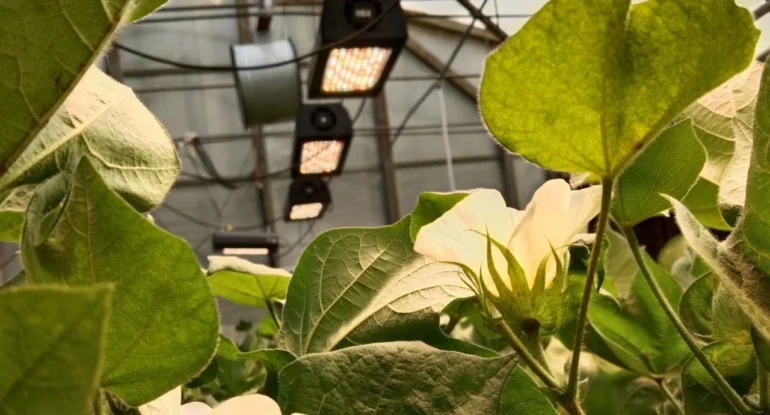
Accelerating Cotton Breeding through Speed Breeding Techniques

Introduction: Cotton is an essential crop worldwide, used as a raw material for the textile industry and other products. However, cotton’s productivity is affected by various biotic and abiotic stresses, such as insect pests, diseases, drought and high temperatures. Breeding programs have played a vital role in enhancing cotton productivity and quality. Speed Breeding is a technique that aims to shorten the generation time, accelerating the breeding process by creating an ideal environment. This report discusses the Speed Breeding Trials conducted on Cotton, resulting in reducing the time to boll opening to just 90 to 100 days.
Methodology: The Speed Breeding technique aims to shorten the generation time and accelerate breeding in Cotton crop. The trials utilized various techniques such as increasing photosynthetic activity, controlling photoperiod for early flower induction, providing optimum control conditions for healthy seed growth and using customized nutrient recipes. The trials were conducted in a controlled environment, with an appropriate lighting protocols, temperature, and humidity control. Seeds were sown and watering, fertigation was managed manually. Plants were subjected to different photoperiod in different phases of growth.
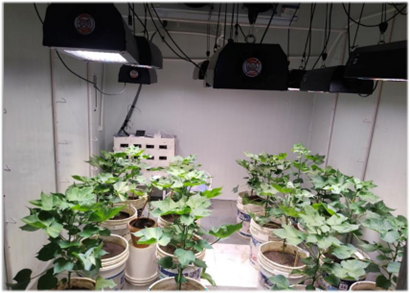
Challenges: The Speed Breeding trials faced challenges, such as chlorosis (figure 2) and nutrient deficiencies (figure 3). These challenges were later addressed in the follow-up trials by adjusting environmental parameters, such as light intensity, airflow and amending the nutrient recipes. Different light intensities were tested to determine the optimal level that would not cause leaf chlorosis.
The nutrient deficiencies observed in the previous trials were addressed by developing different nutrient recipes and fertigation protocols. A customized nutrient combo was developed for cotton speed breeding, which ensured that the plants had optimum nutrient levels at each stage of growth. Additionally, the fertigation protocols were adjusted to ensure that the plants received the right amount of water and nutrients. The trials also made use of controlled temperature to create optimal growth conditions for healthy seed formation.
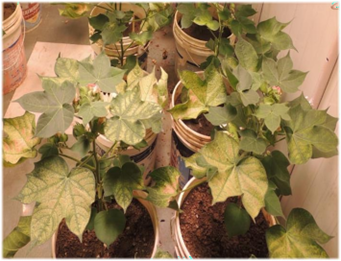

Observations:
- The true leaf stage was achieved in five days
- Square initiation was observed between 25 to 30 days
- Flowering occurred between 45 to 50 days
- Boll formation was observed between 75 to 80 days
- Mature embryo formation occurred after 85 days
- Boll opening occurred between 90 to 100 days
The trials showed an increase in the number of squares and early flowering, leading to higher
cotton yield. Additionally, the shorter internodal distance without any growth retardant spray indicated healthy plant growth. The Speed Breeding trials achieved good vegetative growth, leading to healthy cotton crops. However, leaf chlorosis and nutrient deficiencies were observed, which were addressed in follow-up trials. By adjusting environmental parameters, such as light intensity, nutrient recipes, fertigation protocols, and airflow, the challenges were addressed, resulting in a comprehensive standardized Speed Breeding Solution for Cotton.
Achievements: The Speed Breeding trials achieved good vegetative growth, early flowering, and yielded more squares than what would typically be observed in cotton grown under a polyhouse and a shorter internodal distance without any growth retardant spray. The increase in the number of squares and early flowering helps produce more bolls, ultimately leading to higher cotton yield. Additionally, the shorter internodal distance without any growth retardant spray indicates healthy plant growth. The trials resulted in a healthy cotton crop that was not affected by bioticand abiotic stresses. Furthermore, the speed breeding technique reduced the generation time, resulting in three generations per year, making cotton breeding more efficient.
Conclusion: The development of the comprehensive standardized Speed Breeding Solution for Cotton resulted in a significant reduction in the generation time, allowing for three generations per year. This efficiency helps save time for genetic improvement and accelerates the breeding cycle, leading to a faster and more sustainable process for enhancing cotton’s productivity and quality. Additionally, this technique can also help researchers address cotton’s biotic and abiotic stresses, leading to more efficient and sustainable cotton production.



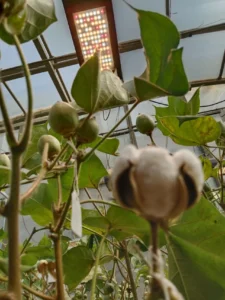
The Cotton Speed Breeding Project was led by our esteemed associate, Shraddha Tiwari. She is an expert in breeding activities and has been part of our team for the past four years.
Comments (2)
Leave A Comment Cancel reply
- Blog Categories
- Basic of Artificial Lighting for Plants
- Basic of grow Light
- Case Studies
- General Awareness
- Indoor Vertical Farming
- Medical Plant Research
- Online Tool
- Pitch Grow Light
- Plant Lighting Measurement
- Speed Breeding
- Supplemental Lighting
- Tissue Culture Grow Lights
- Vertical Green Wall
- LED Grow Lights
- Pharma Segment
- General
Popular Products

Enquire Now
Quick Link
Other Links
Design & Developed By VBTEK




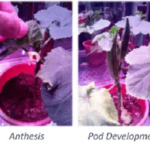









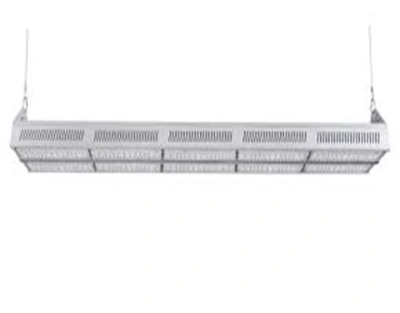






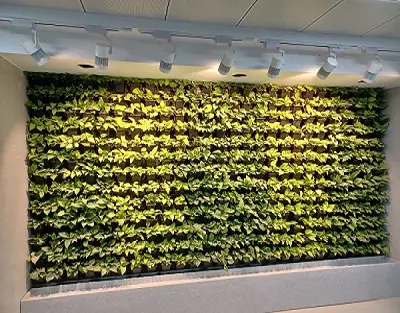





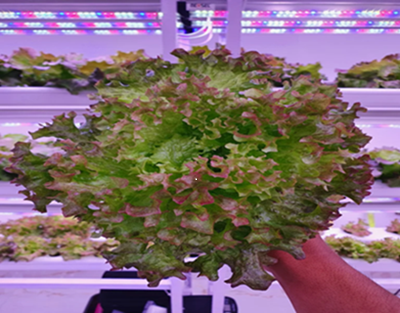




DR Muahmmad Idrees Khan
I want to in hand maximum literature about Seed breeding cotton crop please.
DR Muahmmad Idrees Khan
I am a Cotton Breeder, working in Pakistan Central Cotton Committee, Pakistan want to in hand maximum literature about Seed breeding cotton crop please.